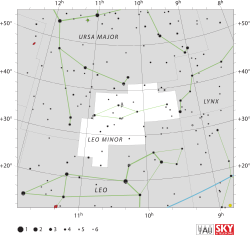Astronomy:Beta Leonis Minoris
| Observation data Equinox J2000.0]] (ICRS) | |
|---|---|
| Constellation | Leo Minor |
| Right ascension | 10h 27m 53.000s[1] |
| Declination | +36° 42′ 25.96″[1] |
| Apparent magnitude (V) | 4.21 (4.40/6.12)[2] |
| Characteristics | |
| Spectral type | G9III[3] |
| U−B color index | +0.64[2] |
| B−V color index | +0.90[2] |
| R−I color index | +0.46[2] |
| A | |
| Spectral type | G8III-IV[2] |
| B | |
| Spectral type | F8IV[2] |
| Astrometry | |
| Radial velocity (Rv) | 8.52[4] km/s |
| Proper motion (μ) | RA: −127.68[1] mas/yr Dec.: −110.31[1] mas/yr |
| Parallax (π) | 21.19 ± 0.50[1] mas |
| Distance | 154 ± 4 ly (47 ± 1 pc) |
| Absolute magnitude (MV) | +0.85[4] |
| Orbit[5] | |
| Period (P) | 13,965±40 |
| Semi-major axis (a) | 0.3782″±0.0007″ |
| Eccentricity (e) | 0.680±0.002 |
| Inclination (i) | 81.4±0.1° |
| Periastron epoch (T) | 2451411.1±4.8 JD |
| Argument of periastron (ω) (secondary) | 215.7±0.2° |
| Semi-amplitude (K1) (primary) | 7.93±0.05 km/s |
| Semi-amplitude (K2) (secondary) | 12.32±0.18 km/s |
| Details | |
| A | |
| Mass | 2.98±0.10[5] M☉ |
| Radius | 9.4±0.3[5] R☉ |
| Luminosity (bolometric) | 50.7±1.8[5] L☉ |
| Surface gravity (log g) | 2.85[4] cgs |
| Temperature | 4,097±927[5] K |
| Metallicity [Fe/H] | +0.09[4] dex |
| Rotational velocity (v sin i) | 2.54[4] km/s |
| Age | 1.2[4] Gyr |
| B | |
| Mass | 1.92±0.04[5] M☉ |
| Radius | 3.7±1.5[5] R☉ |
| Luminosity (bolometric) | 9.1±4.1[5] L☉ |
| Temperature | 5,211±843[5] K |
| Other designations | |
| Database references | |
| SIMBAD | data |
Beta Leonis Minoris, Latinized from β Leonis Minoris, is a binary star in the constellation of Leo Minor. It has an overall apparent visual magnitude of approximately 4.2. Although it is the only star in Leo Minor with a Bayer designation, it is only the second brightest star in the constellation (the brightest is 46 Leonis Minoris).[8]
Binary system
β Leonis Minoris is a binary that can be resolved for a portion of each orbit. When the two components are too close to resolve, it appears as a single G9 giant star with some indications of a second set of spectral lines. The orbit derived as a double-lined spectroscopic binary is poor, and a better orbit has been calculated using only the spectral lines of the primary, plus input from the known visual observations. The orbital period is nearly 39 years and the eccentricity is high at 0.683. The semi-major axis of the orbit is 0.36″, but the separation varies from 0.1 to 0.6″.[9]
The primary star is a late G-class red clump giant, a star that is fusing helium in its core and lies at the cool end of the horizontal branch.[10] The properties of the secondary star can only be estimated from its relative brightness and its spectral class. It is an F8 subgiant, hotter than the sun and starting to evolve away from the main sequence.[8]
References
- ↑ Jump up to: 1.0 1.1 1.2 1.3 1.4 Van Leeuwen, F. (2007). "Validation of the new Hipparcos reduction". Astronomy and Astrophysics 474 (2): 653–664. doi:10.1051/0004-6361:20078357. Bibcode: 2007A&A...474..653V.
- ↑ Jump up to: 2.0 2.1 2.2 2.3 2.4 2.5 2.6 HR 4100, database entry, The Bright Star Catalogue, 5th Revised Ed. (Preliminary Version), D. Hoffleit and W. H. Warren, Jr., CDS ID V/50. Accessed on line October 1, 2008.
- ↑ Keenan, Philip C.; McNeil, Raymond C. (1989). "The Perkins Catalog of Revised MK Types for the Cooler Stars". The Astrophysical Journal Supplement Series 71: 245. doi:10.1086/191373. Bibcode: 1989ApJS...71..245K.
- ↑ Jump up to: 4.0 4.1 4.2 4.3 4.4 4.5 Deka-Szymankiewicz, B.; Niedzielski, A.; Adamczyk, M.; Adamów, M.; Nowak, G.; Wolszczan, A. (2018). "The Penn State - Toruń Centre for Astronomy Planet Search stars. IV. Dwarfs and the complete sample". Astronomy and Astrophysics 615: A31. doi:10.1051/0004-6361/201731696. Bibcode: 2018A&A...615A..31D.
- ↑ Jump up to: 5.0 5.1 5.2 5.3 5.4 5.5 5.6 5.7 5.8 Wang, Xiaoli et al. (September 2020). "The Improved Orbit Solution and Component Masses of bet LMi". The Astronomical Journal 160 (3): 5. doi:10.3847/1538-3881/aba7bd. 141. Bibcode: 2020AJ....160..141W.
- ↑ Entry 10279+3642, The Washington Double Star Catalog , United States Naval Observatory. Accessed on line October 1, 2008.
- ↑ HD 90537 -- Spectroscopic binary, database entry, SIMBAD. Accessed on line October 1, 2008.
- ↑ Jump up to: 8.0 8.1 Beta LMi , Stars, Jim Kaler. Accessed on line October 2, 2008.
- ↑ Griffin, R. F. (2008). "Spectroscopic binary orbits from photoelectric radial velocities - Paper 200: Kappa Persei, Beta Leonis Minoris, 56 Ursae Majoris, HR 4593, and 39 Cygni". The Observatory 128: 176. Bibcode: 2008Obs...128..176G.
- ↑ Adelman, Saul J. (2001). "On the Photometric Variability of Red Clump Giants". Baltic Astronomy 10 (4): 593. doi:10.1515/astro-2001-0404. Bibcode: 2001BaltA..10..593A.
Coordinates: ![]() 10h 27m 53s, +36° 42′ 26″
10h 27m 53s, +36° 42′ 26″
 |


